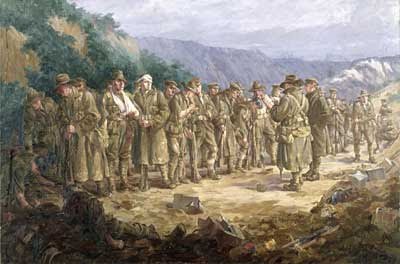 Ellis Luciano Silas, artist, was born in London on 13 July 1885. His father was an artist and designer and his mother an opera singer. He was educated by private tutors before working in his father’s studio, where he studied under the well-known artist Walter Sickert. Marine art became his main interest and he painted in English coastal towns. In 1907, he sailed to Australia where he spent time painting in Sydney, Melbourne and Adelaide before he settled in Perth.
Ellis Luciano Silas, artist, was born in London on 13 July 1885. His father was an artist and designer and his mother an opera singer. He was educated by private tutors before working in his father’s studio, where he studied under the well-known artist Walter Sickert. Marine art became his main interest and he painted in English coastal towns. In 1907, he sailed to Australia where he spent time painting in Sydney, Melbourne and Adelaide before he settled in Perth.On 16 October 1914, Silas that joined the AIF (Australian Imperial Force) as a signaller with the 16th Battalion. He had served in the Royal Naval Volunteer Reserve (RNVR) for three years and had a strong sense of patriotism, but was doubtful about his ability to be a successful soldier and would have preferred a position as a medical orderly. On 18 November, he embarked with the battalion on the Dimboola, for Melbourne. The ship stopped at Adelaide and the men were given four hours leave. It gave Silas just enough time to:
Dash off to the Art Gallery to see one of my favourite paintings, “Circe invidiosa” by Waterhouse - colour glorious and general treatment most decorative.
The Dimboola went on to Melbourne, where the men disembarked and started training at Broadmeadows camp.
On 22 December 1914, Silas sailed with his battalion on the Ceramic for Egypt, where he trained at Heliopolis, near Cairo. He found army life distasteful, but persevered with signalling, and when possible, continued his sketching and painting.
At about 6 pm on 25 April 1915, Silas went ashore at Gallipoli with the 16th Battalion. The battalion was sent immediately to Pope’s Hill at the head of Monash Valley, where they spent the night digging in under intense rifle fire. Silas later recorded his first experiences in his painting, The End of the Great Day: The 16th Battalion, AIF digging the original trenches on Pope’s Hill on the evening of the landing at Anzac, 25 April 1915 - By an eyewitness (Signaller Ellis Silas, 16th Battalion AIF).
For the next five days, the 16th held Pope’s Hill against the Turks. As Silas recorded in his drawings of that period:
The repetition of shrapnel in each sketch is not a fad of mine, but just the natural order of things: they became as much part of the landscape as the clouds.
Constant exposure to heavy fire during his time at Gallipoli caused Silas to suffer from neurasthenia, otherwise known as shell-shock. On 17 May, he was put aboard the hospital ship Galeka and eventually admitted to No 1 AGH (Australian General Hospital) in Egypt with neurasthenia and enteric fever. Silas was sent to convalesce in England and was discharged from the AIF as medically unfit on 17 August 1916. Silas’ experience of Gallipoli, recorded in his diary and sketchbook, were published in 1916 as Crusading at Anzac, AD 1915. In his foreword, he wrote:
In this work I have not touched upon the big historical facts, but have endeavoured to portray War as the soldier sees it, shorn of all its pomp and circumstance; the War that means cold and hunger, heat and thirst, the ravages of fever; the War that brings a hail of lead that tears the flesh and rends the limb, and makes of men, heroes.
While waiting in London for a passage back to Australia, Silas painted works depicting war at Gallipoli. Three of these were bought for the Australian War Memorial collection, including his piece Roll Call. Silas was one of very few artists who recorded in sketches and paintings his own first-hand experiences of the Australian participation at Gallipoli.
 In 1921, Silas returned to Australia and lived in Sydney where he worked as a commercial artist and contributed cartoons and articles to the Bulletin. In 1922, he went to the Trobriand Islands, New Guinea, to paint, and in 1925 returned to England to work as a marine artist. His painting ‘The Price of Glory’, begun in Perth and depicting the First Dutch War, caused a minor sensation at the Royal Academy of Arts in 1934. It now hangs in the National Maritime Museum at Greenwich in England. He also designed posters, illustrated books and painted commissioned works to hang on ocean liners.
In 1921, Silas returned to Australia and lived in Sydney where he worked as a commercial artist and contributed cartoons and articles to the Bulletin. In 1922, he went to the Trobriand Islands, New Guinea, to paint, and in 1925 returned to England to work as a marine artist. His painting ‘The Price of Glory’, begun in Perth and depicting the First Dutch War, caused a minor sensation at the Royal Academy of Arts in 1934. It now hangs in the National Maritime Museum at Greenwich in England. He also designed posters, illustrated books and painted commissioned works to hang on ocean liners.Silas married Ethel Florence Detheridge in London in 1927, and she survived him when he died in London on 2 May 1972.
No comments:
Post a Comment